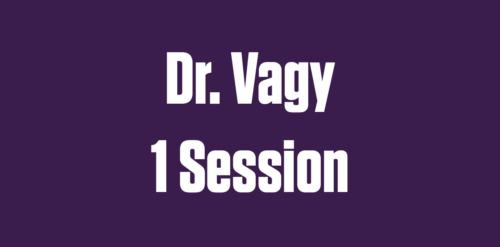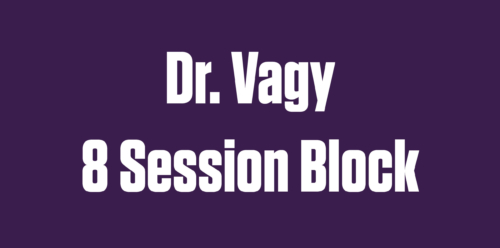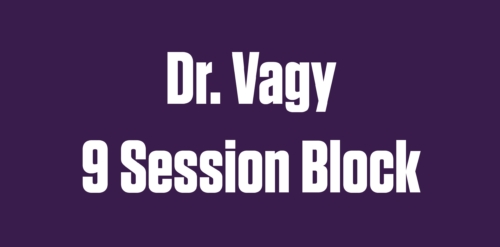-
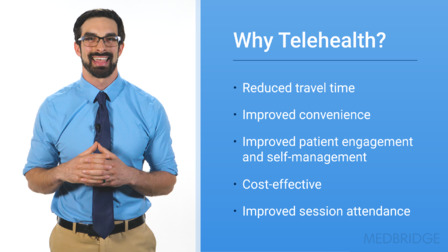 Virtual care delivery presents with unique organizational, practitioner, and patient benefits and barriers that do not exist within traditional in-person care. Effective use of telehealth requires the provider to recognize whether or not a patient is appropriate for telehealth, communicate the advantages and disadvantages with the patient, and understand how to resolve technical issues. The goal of this course is to address these challenges and provide clinicians with best-practice strategies to effectively incorporate telehealth into their care delivery.
Virtual care delivery presents with unique organizational, practitioner, and patient benefits and barriers that do not exist within traditional in-person care. Effective use of telehealth requires the provider to recognize whether or not a patient is appropriate for telehealth, communicate the advantages and disadvantages with the patient, and understand how to resolve technical issues. The goal of this course is to address these challenges and provide clinicians with best-practice strategies to effectively incorporate telehealth into their care delivery. -
 This course will introduce clinicians to best practices for gathering patient history during a telehealth subjective exam. Telehealth continues to be a widely used patient care model, and there are some significant differences in taking a patient's history during a telehealth visit when compared to an in-person visit. This course will go over the essentials for getting started with a subjective exam and how to improve communication remotely, structure a subjective exam in the remote environment, and determine if a patient is appropriate for telehealth.
This course will introduce clinicians to best practices for gathering patient history during a telehealth subjective exam. Telehealth continues to be a widely used patient care model, and there are some significant differences in taking a patient's history during a telehealth visit when compared to an in-person visit. This course will go over the essentials for getting started with a subjective exam and how to improve communication remotely, structure a subjective exam in the remote environment, and determine if a patient is appropriate for telehealth. -
 This course will introduce clinicians to best practices for performing a telehealth objective exam. Telehealth continues to be a widely used patient care model, and there are many differences in performing an objective exam during a telehealth visit when compared to an in-person visit. Most notably, the absence of the ability to perform manual assessments poses a challenge for obtaining accurate tests and measures remotely. This course addresses this challenge by providing alternate strategies for physical tests and measures that clinicians can apply directly to their practice in a telehealth model. This course will cover how to structure the objective exam as well as how to assess posture, movement, mobility, muscle performance, and a variety of other tests and measures during a telehealth visit.
This course will introduce clinicians to best practices for performing a telehealth objective exam. Telehealth continues to be a widely used patient care model, and there are many differences in performing an objective exam during a telehealth visit when compared to an in-person visit. Most notably, the absence of the ability to perform manual assessments poses a challenge for obtaining accurate tests and measures remotely. This course addresses this challenge by providing alternate strategies for physical tests and measures that clinicians can apply directly to their practice in a telehealth model. This course will cover how to structure the objective exam as well as how to assess posture, movement, mobility, muscle performance, and a variety of other tests and measures during a telehealth visit. -
 This course will introduce clinicians to best practices for performing Telehealth interventions. Telehealth continues to be a widely used patient care model and there are differences in providing patient interventions during a telehealth visit when compared to an in-person visit. This course addresses these differences by providing alternate strategies for interventions that clinicians can directly apply to their practice in a telehealth model. This course will cover remote interventions related to neuromuscular re-education, joint/muscle mobility, muscle performance, and patient education
This course will introduce clinicians to best practices for performing Telehealth interventions. Telehealth continues to be a widely used patient care model and there are differences in providing patient interventions during a telehealth visit when compared to an in-person visit. This course addresses these differences by providing alternate strategies for interventions that clinicians can directly apply to their practice in a telehealth model. This course will cover remote interventions related to neuromuscular re-education, joint/muscle mobility, muscle performance, and patient education -
 This is an interactive course that will teach you how to identify faulty alignment and movement patterns in the knee by analyzing patient posture and movement. You will learn how to use components of the movement system to classify patients with movement faults and mechanical knee pain. Based on movement classifications, you will hypothesize mobility and muscle performance deficits contributing to a patient's symptoms. You will integrate symptom modification procedures into your interventions and learn how to restore optimal posture and movement of the knee.
This is an interactive course that will teach you how to identify faulty alignment and movement patterns in the knee by analyzing patient posture and movement. You will learn how to use components of the movement system to classify patients with movement faults and mechanical knee pain. Based on movement classifications, you will hypothesize mobility and muscle performance deficits contributing to a patient's symptoms. You will integrate symptom modification procedures into your interventions and learn how to restore optimal posture and movement of the knee. -
 This is an interactive course that will teach you how to identify faulty scapular alignment and movement patterns in the shoulder by analyzing patient posture and movement. You will learn how to use components of the movement system to classify patients with scapular movement faults and mechanical shoulder pain. Based on movement classifications, you will hypothesize which mobility and muscle performance deficits are contributing to a patient's symptoms. You will integrate symptom modification procedures into your interventions and learn how to restore optimal posture and movement of the scapula.
This is an interactive course that will teach you how to identify faulty scapular alignment and movement patterns in the shoulder by analyzing patient posture and movement. You will learn how to use components of the movement system to classify patients with scapular movement faults and mechanical shoulder pain. Based on movement classifications, you will hypothesize which mobility and muscle performance deficits are contributing to a patient's symptoms. You will integrate symptom modification procedures into your interventions and learn how to restore optimal posture and movement of the scapula. -
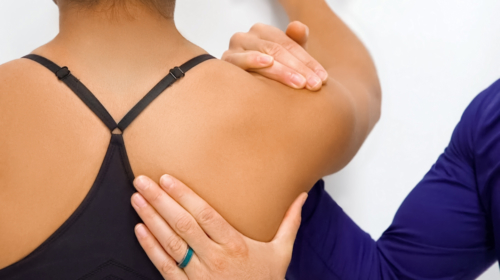 This is an interactive course that will teach you how to identify faulty humeral alignment and movement patterns in the shoulder by analyzing patient posture and movement. You will learn how to use components of the movement system to classify patients with humeral movement faults and mechanical shoulder pain. Based on movement classifications, you will hypothesize mobility and muscle performance deficits contributing to a patient's symptoms. You will integrate symptom modification procedures into your interventions and learn how to restore optimal posture and movement of the humerus.
This is an interactive course that will teach you how to identify faulty humeral alignment and movement patterns in the shoulder by analyzing patient posture and movement. You will learn how to use components of the movement system to classify patients with humeral movement faults and mechanical shoulder pain. Based on movement classifications, you will hypothesize mobility and muscle performance deficits contributing to a patient's symptoms. You will integrate symptom modification procedures into your interventions and learn how to restore optimal posture and movement of the humerus. -
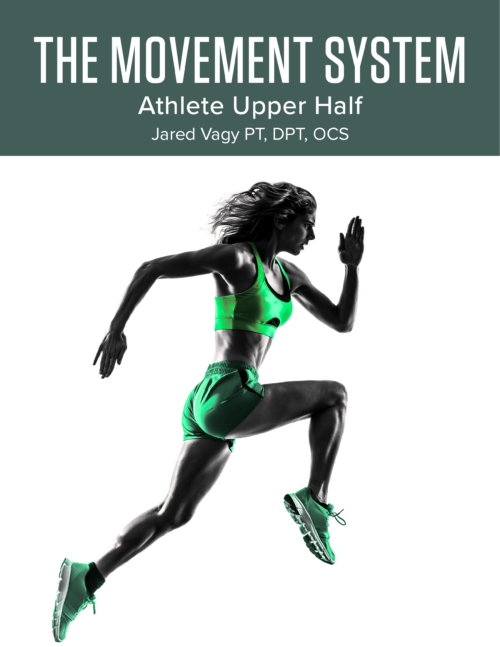
Course Description
This online course teaches you how to use the movement system to assess, diagnose and treat athlete movement dysfunction. The sports covered include tennis, swimming, baseball, volleyball, rock climbing and several additional upper body sports. You will watch lectures, complete knowledge checks, analyze movement videos, and learn about sport-specific interventions. After completing the modules, you will attend the in-person course. The course is lab based and highly interactive with an emphasis placed on the practical application of key principles from the modules. At the conclusion the course, you will have a greater understanding of how to integrate movement based assessments into sport-specific treatments.
*Course fees do not include tax and/or VAT. Additional taxes will be calculated separately at checkout based on your geographic location. -
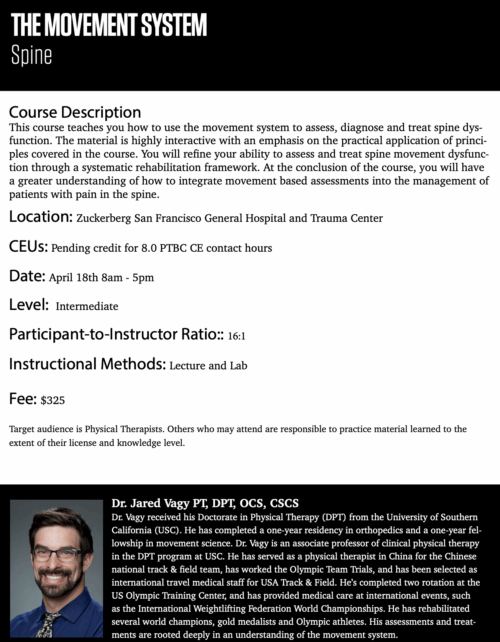
Course Description
This course teaches you how to use the movement system to assess, diagnose and treat spine dysfunction. The material is highly interactive with an emphasis on the practical application of principles covered in the course. You will refine your ability to assess and treat spine movement dysfunction through a systematic rehabilitation framework. At the conclusion of the course, you will have a greater understanding of how to integrate movement based assessments into the management of patients with pain in the spine.
-

Course Description
This course teaches you how to use the movement system to assess, diagnose and treat athlete lower half movement dysfunction. The course is delivered in a hybrid model where you will log into a course portal to complete modules of content. The emphasis is placed on endurance, speed, power, and agility components of sport. You will watch lectures, complete knowledge checks, analyze movement videos, and learn about sport-specific interventions. After completing the modules, you will attend the in-person course. The course is lab based and highly interactive with an emphasis placed on the practical application of key principles from the modules. At the conclusion the course, you will have a greater understanding of how to integrate movement based assessments into sport-specific treatments.
-

Course Description
This course teaches you how to use the movement system to assess, diagnose and treat movement dysfunction. The material is highly interactive with an emphasis on the practical application of principles covered in the course. The course follows closely the MSI model. Concepts utilized in the course include closed kinetic chain muscle testing, dynamometry, anatomical slings, neuromuscular chains, dual vectors and reflexive activation. At the conclusion of the course, you will have a greater understanding of how to integrate movement based assessments into patient-specific treatments.

